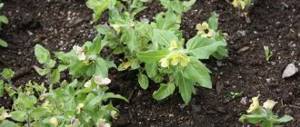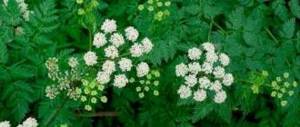Crow's eye is unsafe in large quantities. All parts of the plant contain toxic substances that disrupt the functioning of the nervous system. But when used correctly, cuckoo tears have a healing effect: they relieve muscle spasms, soothe, and relieve pain. External use of products based on plant extracts does not cause harm - alcohol tinctures can relieve inflammation of the joints. It is not recommended to abuse homeopathic medicines, otherwise poisoning of the body may occur.
Medicinal properties of raven's eye
However, despite all its toxicity, the herb is very effective in the treatment of certain diseases, as it has antispasmodic, anti-inflammatory, diuretic, sedative, and wound-healing properties .
- Decoctions are used in the treatment of neuralgia, migraines, dizziness, and mental disorders.
- Crow's eye juice, like the camel thorn plant, has diuretic properties.
- Freshly squeezed juice is also excellent for healing wounds, bites, and skin diseases.
- The plant is used to treat tuberculosis, fever, and bronchitis. Alcohol tinctures are used to help with heart failure and tachycardia.
- Lotions with a decoction help with conjunctivitis.
Healing properties
As mentioned above, crow's eye is a toxic plant, but dried parts have some use in alternative medicine.
Pounded fruits are applied to difficult-to-heal abrasions, cuts, pimples and blackheads.
To get rid of headaches, folk healers advise rubbing the temples with the juice of this plant.
The Crow's Eye has:
- vitamin C;
- citric acid;
- malic acid;
- other organic acids;
- pectin substances;
- coumarin.
Be sure to read:
St. John's wort - application and beneficial properties
Thanks to these substances, the plant relieves cramps, calms the nerves, and heals wounds. It is also a diuretic and antiphlogistic agent. Alleviates the manifestations of tuberculosis, inflammation of the larynx, neuralgia, headaches and diseases that cause metabolic disorders.
Crow's eye has found its use as an aid for spasms, concussions, and heart problems. It is also used to stabilize heart function, improve digestion, and stimulate appetite.
Before consuming this plant in any form, be sure to consult your doctor.
Use in folk medicine
The plant is not used in traditional medicine , but traditional healers have found use for the beneficial properties of the raven's eye, only when prescribing, strict contraindications are taken into account and dosages are carefully observed.
- For laryngitis, dizziness, nervous tics, and problems with metabolism, this tincture helps: 2 g of freshly cut, finely crushed herbs, pour 0.10 liters of alcohol (70%). Wait a week. Strain thoroughly. Dilute 2 tbsp in a glass of water. l. infusion. Apply 1 tbsp. l. every 2 hours, but not more than 200 ml per day.
- For a concussion, a tincture is recommended: for 4 glasses of dry herb, use 0.50 liters of vodka. Pour vodka over the raw materials, close and leave for 9 days in a warm place. Drink three times a day, 5 drops per 50 g of water.
- For heart failure aggravated by edema, a tincture is prescribed: 12 freshly picked fruits, pour 0.50 liters of vodka. Leave in a dark place for 15 days. Take 3 weeks three times a day, dissolving 20 to 30 drops in 50 g of water. Take a 10 day break. Repeat the course.
- The same tincture helps with diseases of the nervous system, only in a different dosage: 1 tbsp. l. Dilute the infusion in 0.20 liters of water, consume 1 tbsp. l. every 2 hours, no more than 200 ml per day.
- For blepharitis and conjunctivitis, they use lotions: take equal parts of crow's eye and open arrow grass, flowers of meadow clover, geranium and bird cherry, and blue cornflower. 1 tbsp. l. steam the collection in 0.20 liters of boiling water and leave for an hour.
- For non-healing wounds and boils, prepare an ointment: thoroughly grind fresh berries with a mortar. Apply to a wound or boil once a day, no more.
Description
| Binary nomenclature | Paris quadrifolia |
| Folk names | Bear berries, crow grass, cross-grass, crow's eyes, wolf berries, rodimets-grass, forest podbel, parid grass |
| Root | Oblong, creeping |
| Stem | Thin, short (10-45 cm), erect |
| Flower | Large, single, apical. Includes 4 petals and 4 sepals |
| Fetus | Blackish blue round berry |
| Leaves | 4 leaves tightly seated in a whorl |
| Bloom | Early - mid May. Duration – 5-10 days. |
| Reproduction | Vegetatively and by seeds contained in the fruit |
| Features of life | They grow in coniferous and deciduous forests. Preferably in damp, shady areas |
| Application | Alternative medicine |
| Parts used | Berries, aerial part |
Contraindications for use
Toxic substances contained in abundance in the plant require especially careful handling of all preparations that contain its berries or leaves. Before using raven's eye, it is necessary to consult a doctor so that instead of the expected benefit, you do not end up causing significant harm to the body. It is very important to scrupulously adhere to the dosage.
Preparations containing this plant are contraindicated:
- pregnant women, as well as during breastfeeding;
- children under 12 years old;
- for hypertension;
- with manifestations of insomnia;
- for kidney diseases;
- in cases of an allergic reaction to the drug.
An overdose can cause vomiting, diarrhea, dizziness, and colic. It becomes difficult for a person to breathe, painful sensations appear in the heart area, a burning sensation in the mouth, larynx, stomach, convulsions and even paralysis may occur.
In such cases, first of all, it is necessary to rinse the stomach, take activated charcoal, anesthesin. To eliminate the irritating reaction on the mucous membranes, it is good to swallow pieces of ice. Contact your doctor immediately.
Chemical composition
Botanical scientists have studied the crow's eye in detail and have long established that its danger is primarily due to the fact that the berries and rhizome contain the glycosides paridin and paristifin, which clearly exhibit a neurotoxic effect, have a toxic effect on the nervous tissue, destroying it. At the same time, in a reasonable prescribed dosage, they can also help in the fight against neoplasms, eliminate any disturbances in blood flow, normalizing blood composition and its density, and fight fungal infections and inflammatory processes.
The plant also contains steroid saponins, the role of which is to suppress the development of pathogenic microorganisms, and very useful flavonoids, which have a beneficial effect on capillary walls, strengthening them and normalizing the activity of the heart muscle.
The list of beneficial components of raven's eye includes coumarins, which help thin the blood and prevent blood clots, as well as pectins, substances that help maintain normal intestinal microflora.
The plant also contains a set of organic acids, thanks to which the immune system, digestive tract, and every cell of the body function in maintaining the acid-base balance of the human body, which improves the general condition and well-being of a person and increases his life potential. Vitamin C, which is found in abundance in the herb, also plays approximately the same role.
Collection and storage of plants
To prepare medicines, the herbal part of the plant is harvested during flowering - in May-June, and used fresh. The berries are collected after full ripening, in August, and are often used fresh to prepare tinctures, sometimes dried.
Those who are interested in the centuries-old experience of traditional healers using natural resources to treat all sorts of ailments will certainly find detailed articles about the benefits and harms of grapes for the human body, as well as the numerous ways to use Veronica officinalis.
You, dear readers, in turn, will also share your knowledge and experience in using folk recipes. Have you heard of the raven's eye, or maybe you've already used it? Tell us about a similar experience.
Where does the poisonous plant grow?
Crow's eye is often found in Russia, and not only.
Common habitats of the plant:
- Crimea.
- Western Siberia.
- Kamchatka.
- Caucasus.
- Sakhalin.
- Primorye.
- Amur region.
Crow's eye breeds easily in rocky and rocky terrain. There are some species that prefer fields as a habitat.
It is not uncommon to find it in deciduous and coniferous forests, where fertile soil creates favorable conditions for life.
Is there any benefit...
Crow's eye six-leaved, that is, Far Eastern, has insecticidal properties. I really hope that you will not test these properties in practice.
The plant is occasionally used in folk medicine to treat migraines, neuralgia, and metabolic disorders. Preparations from the aerial parts of the plant were popularly used for pulmonary tuberculosis and as external wound-healing agents. The rhizomes have been used in Chinese medicine, particularly in the treatment of cancer. By the way, there are no medications based on raven's eye.
Literature:
- Vascular plants of the Soviet Far East. T. 3. / Rep. ed. S. S. Kharkevich. - L.: Nauka, 1988. - 421 p.
- Fruentov Nikolay Konstantinovich, Kadaev Gennady Nikolaevich. Poisonous plants. Medical toxicology of plants of the Far East. Khabarovsk, Kn. Ed. 1971.
- Fruentov, Nikolai Konstantinovich. Medicinal plants of the Far East. 3rd edition, expanded and expanded. – Khabarovsk: Book. Publishing house, 1987. – 352 pp., 0.5 l. ill.
- Shreter, Alexey Ivanovich. Medicinal flora of the Soviet Far East. – M.: Medicine, 1975.
Total votes: 3 ; average score: 5.00 out of 5 .
Distinctive features of the poisonous berry
All lovers of wild berries should know what a raven's eye looks like. Inexperienced tourists may confuse the poisonous crowberry with blueberries. Crow's eye berries differ from edible fruits primarily in their smell. Just rub the picked fruit in your palms and sniff: the unpleasant aroma is unlikely to cause appetite.
Of course, you should pay attention to the grouping of fruits. Crow's eye grows singly, while blueberry fruits are always located nearby in several pieces.
What to do if you or your child accidentally ate crowberry
In fact, one berry will not cause damage to your health. The proven “dangerous” dose is 10 berries. It will not be possible to accidentally eat such an amount, because the taste of the fruit is very unpleasant. If several berries get into the stomach, then you need to induce vomiting and drink strong black tea.
Notes[ | ]
- For the convention of indicating the class of monocots as a higher taxon for the group of plants described in this article, see the section “APG Systems” of the article “Monocots”.
- The world's largest nuclear cell genome has been discovered - YUGA.ru
- Barabanov, E. I.
Botany: a textbook for students. higher textbook establishments. - M: Publishing house. , 2006. - P. 364. - 448 p. — ISBN 5-7695-2656-4. - Species in Paris
(English).
The Plant List (2013).
Version 1. Published on the Internet; https://www.theplantlist.org/ . Royal Botanic Gardens, Kew and Missouri Botanical Garden (2010). Retrieved August 19, 2020. - Flora of the USSR, 1935, p. 469.
What happens if you eat a berry?
The large, bright raven's eye berry looks very attractive and resembles a blueberry. If such a berry is eaten unknowingly or by mistake, then abdominal pain, vomiting, and dizziness appear. When the plant is ingested in a large dose, convulsions begin, interruptions in heart rhythm, and death is possible. When the leaves are ingested, the central nervous system is affected, and the rhizome has an emetic effect.
It is believed that taking one or two berries does not cause dangerous consequences, although individual sensitivity and early age may amend this rule. A dose of 10 berries is considered lethal, although no reliable cases of such fatal outcomes have been recorded.
.
In case of poisoning, it is necessary to rinse the stomach and administer drugs that regulate the functioning of the heart, for which you should immediately call an ambulance; it is also recommended to keep pieces of ice in your mouth.
When carrying out treatment, you should remember that the raven eye requires special care. This plant is contraindicated for children, expectant and nursing mothers, as well as hypertensive patients and persons with increased excitability of the nervous system.
Only ardent fans of botany know about a plant called the raven's eye. But if you love forest walks and often pick berries, then information about what a crow's eye plant looks like can literally save your life!
Crow's eye is poisonous, but looks very similar to blueberries or blueberries. This is why episodes of accidental poisoning are quite common. Be sure to remember the characteristic features of the plant so as not to make a fatal mistake.











